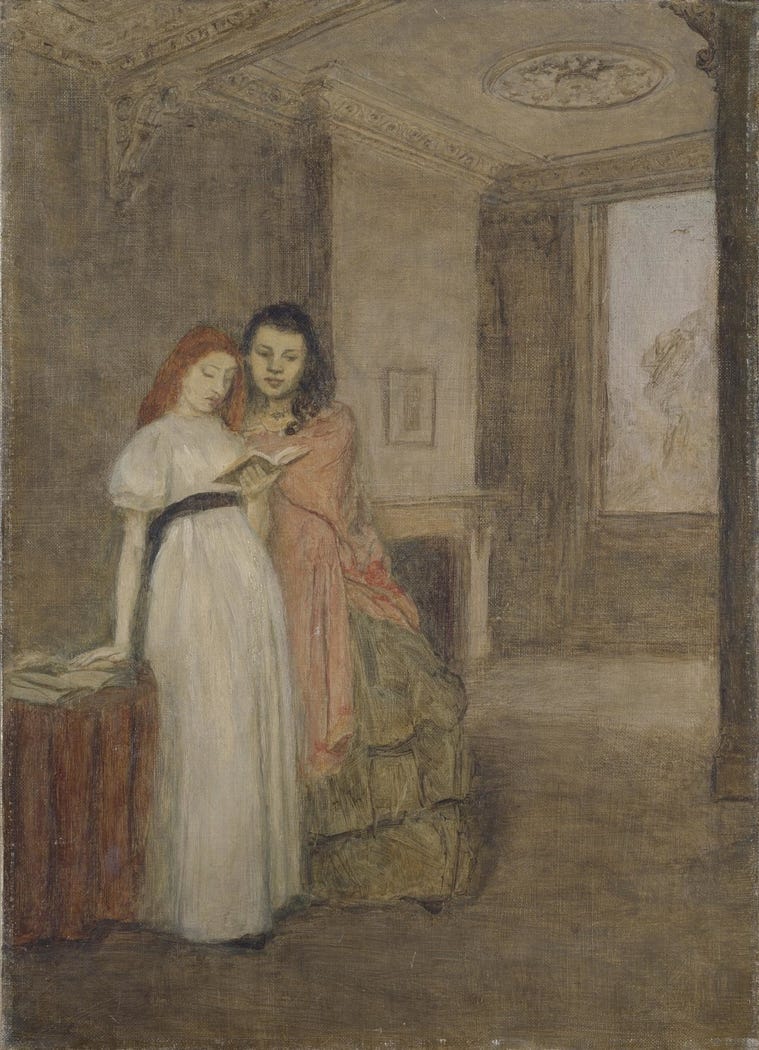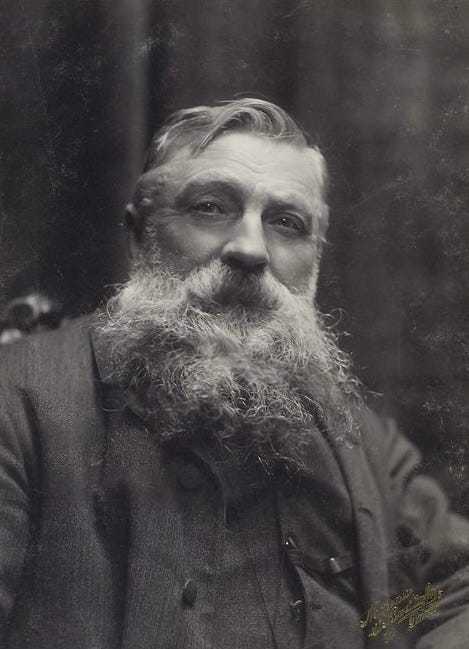Gwen John: A Solitary Life
"Leave everybody and let them leave you. Then only will you be without fear."
Gwen John is now considered one of the twentieth century's most influential British artists. Born in Wales, she spent much of her career in Paris from 1904 until she died in 1939. Known for her muted paintings of solitary female figures, she has often been portrayed as a recluse and, in the past, was overlooked in favour of her brother Augustus John and lover Auguste Rodin. Today, though, with a reputation on the rise, she is seen as a significant figure in British and French art history.
Gwen was born Gwendolen Mary John on the 22nd of June 1876 in Haverfordwest, an ancient county town in Pembrokeshire, Wales. She was the second child of solicitor Edwin William John and his wife Augusta, with an elder brother, Thornton and two younger siblings, Augustus and Winifred. Though Augusta suffered from poor health that often kept her away from the children, she was a talented amateur watercolourist and encouraged their interest in art.
Sadly, Augusta died when Gwen was only eight years old, and soon after, Edwin moved his family to Tenby, a nearby harbour town. Gwen and her younger sister Winifred’s early education was provided by governesses before moving to a small local school, and when not in classes, she and her siblings would explore the coastline, where they would make sketches of the wildlife they saw there.
Aged nineteen, Gwen moved to London to study at the Slade School of Fine Art, working under esteemed tutors like Henry Tonks and Philip Wilson Steer. Her younger brother, Augustus, had begun studying there the year before, and she shared lodgings with him in the city.
The Slade was the only art school in the UK that accepted female enrolment at that time. Unlike the traditional Royal Academy, it also adopted the teaching style of the French ateliers, whereby one master would teach different ability levels.
Founded in 1871 as part of University College, London, it is said to have had two golden eras - the second was in the early twentieth century, with its students including Dora Carrington, Mark Gertler, Paul Nash, C.R.W. Nevinson and Stanley Spencer. The first was while Gwen and Augustus were there, studying alongside future greats such as William Orpen and Percy Wyndham Lewis.
Despite Augustus John's talent and bohemian glamour often overshadowing his sister's quieter personality, Gwen developed her skills at the Slade - and left with several awards. She also formed lifelong friendships with other female students, including Ida Nettleship (future Mrs Augustus John), Ursula Tyrwhitt and Gwen Salmond.
It was with Ida and Gwen Salmond that she first travelled to Paris after graduating from the Slade in 1898 - and the three of them shared an apartment close to an artist community in Montparnasse. Paris was seen as an important centre for students of art, and they enrolled at the Academie Carmen, a studio recently opened by American artist James McNeill Whistler. From Whistler, Gwen adopted a technical approach to art and assumed the distinctive muted tones that identify her work.

She returned to London in 1899 and 1900 made her exhibition debut with Portrait of the Artist, shown at the New English Art Club. Later that year, she returned to France for a short holiday and again in 1903 with her friend Dorothy ‘Dorelia’ McNeill. Dorelia was Augustus John’s model and mistress - and for four years, she lived with him and his wife Ida before becoming his common-law-wife following Ida’s death in 1907.
Gwen and Dorelia set off on a walking tour from Bordeaux to the Italian city of Rome, funding their travel by selling portraits and saving money by sleeping in fields. They made it as far as the vibrant and artistic French city of Toulouse, where Gwen painted a series of portraits of Dorelia, showing her friend in quiet reflection with a pile of books in a gloomy room.
The pair left Toulouse in February 1904, and Gwen returned to Montparnasse, where she supplemented her income by working as an artist’s model - including for the famous French sculptor Auguste Rodin. Rodin had been commissioned by the International Society of Sculptors, Painters and Gravers to create a sculpture in remembrance of James McNeill Whistler, who had died the year before. Rodin was thirty-five years her senior, but he and Gwen became lovers, and their passionate affair lasted ten years, with Gwen writing thousands of letters to him, sometimes three times a day.
In 1911, Gwen moved from Montparnasse to Meudon, a suburb nine miles from the centre of Paris and home to beautiful woods, stunning views over the city, and a vibrant artist community.
Around the same time, American lawyer and art collector John Quinn showed a keen interest in her work and bought the majority of the paintings that she sold. With his patronage, she gave up her life as an artist's model and wholly committed to her painting.
Throughout her life, Gwen had affairs with men and women but could become obsessive about those she loved. Though Rodin cared deeply for her, he found her powerful emotions unsettling and eventually ended the affair. Broken-hearted, she found solace not only in her art but also in religion and, in 1913, became a member of the Roman Catholic Church. She painted several portraits of nuns from a Meudon convent, the Dominican Sisters of Charity - including a series of its founder, Mère Marie Poussepin, who died in 1744.
My religion and my art, these are my life.
With the outbreak of the First World War in 1914, Gwen remained in France. Solitary portraits and muted interiors continued to be the focus of her art, and she held her first Parisian exhibition at the Salon d’Automne in 1919. But, following the death of her patron, John Quinn, in 1924, she worked less, and her last dated piece is a drawing of 20th March 1933.
Gwen spent her later years living alone with her beloved cats in a wooden house on stilts in Meudon. On 10 September 1939, in poor health, she travelled to Dieppe, where she collapsed and died, seemingly of starvation, eight days later.
Though she was well-regarded while alive, her work was largely forgotten following her death. Her final resting place at the Janval Cemetery in Dieppe was unknown until 2014. However, as her brother Augustus predicted, Gwen John is today seen as one of the most significant British artists of the twentieth century.
In fifty years' time, I will be known as the brother of Gwen John.1
Thank you for reading! If you enjoyed this biography, you can subscribe below to become a full member and to access the complete archive and future paid posts. Until next time…
Images:
Images on Beyond Bloomsbury are usually credited. I conduct thorough picture research, but please let me know if you believe a credit needs to be added or corrected. Thank you!
Sources and Recommended Reading:
Foster, Alicia, Gwen John: Art and Life in London and Paris (Thames & Hudson, 2023)
Foster, Alicia, Gwen John (Tate Publishing, 1999)
Holroyd, Michael, Augustus John: The New Biography (Vintage, 1997)
Johnson, Paul, Art: A New History (Harper Collins, 2003)
Lloyd-Morgan, Ceridwen, Gwen John: Papers at the National Library of Wales (National Library of Wales, 1996)
Lloyd-Morgan, Ceridwen, Gwen John: Letters and Notebooks (Tate Publishing, 2004)
Langdale, Cecily & Jenkins, David F., Gwen John: An Interior Life (Phaidon Press, 1985)
Paul, Celia, Letters to Gwen John (Jonathan Cape, 2022)
Roe, Sue, Gwen John: A Painter’s Life (Farrar Straus & Giroux, 2001)
Tamboukou, Maria, Nomadic Narratives, Visual Forces: Gwen John's Letters and Paintings (Peter Lang Publishing, 2010)
Thomas, Alison, Portraits of Women: Gwen John and Her Forgotten Contemporaries (Polity, 1996)
Michael Holroyd, Augustus John: The New Biography (Vintage, 1997)
















Thank you very much for this very interesting biography of Gwen John and for the accompanying paintings that you have selected. Until today I knew little about her except that she was the brother of Augustus John, that he thought she was a better artist and that she was Rodin’s lover. Now I have a picture of key moments frim her whole life. I like some aspects of her paintings, like the depiction of the texture of the pages of the books in one of the ones that you have selected. It would be interesting to know more about her day to day life, and to know what she thought of her friends and lovers and about life in general and what they the thought of her. I guess I should read one or more of the books from your book list. I was saddened to hear of her tragic death.
Those muted tones you describe are just heavenly - a lot in common with Whistler, but distinct as well. It sound like Gwen felt the world very deeply - from painting to lovers. What a passionate soul. Interesting also the elements of money you weave in here and the narrative that money can indeed buy freedom for an artist to truly create without inhibitions.